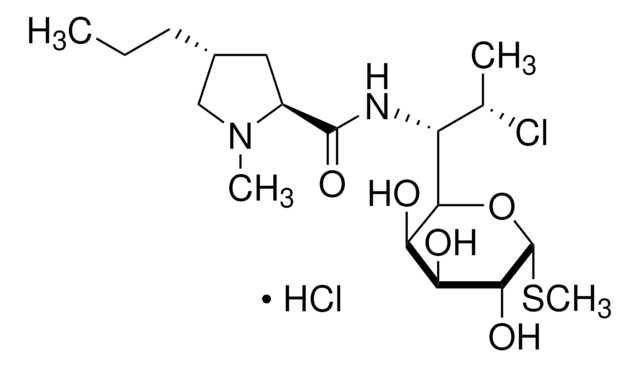Products may be shipped at a different temperature than the recommended long-term storage temperature. If the product quality is sensitive to short-term exposure to conditions other than the recommended long-term storage, it will be shipped on wet or dry-ice. If the product quality is NOT affected by short-term exposure to conditions other than the recommended long-term storage, it will be shipped at ambient temperature. As shipping routes are configured for minimum transit times, shipping at ambient temperature helps control shipping costs for our customers. For more information, please refer to the Storage and Transport Conditions document: https://www.sigmaaldrich.com/deepweb/assets/sigmaaldrich/marketing/global/documents/316/622/storage-transport-conditions-mk.pdf
C5269
Clindamicina hydrochloride
lincosamide antibiotic
Sinónimos:
(7S) -7-Cloro-7-desoxilincomicina hydrochloride, Cleocina
Seleccione un Tamaño
153,00 €
Seleccione un Tamaño
About This Item
153,00 €
Productos recomendados
Formulario
powder or crystals
impurezas
≤13%
solubilidad
H2O: 50 mg/mL
espectro de actividad antibiótica
Gram-negative bacteria
Gram-positive bacteria
Modo de acción
protein synthesis | interferes
temp. de almacenamiento
2-8°C
cadena SMILES
Cl.CCC[C@@H]1C[C@H](N(C)C1)C(=O)N[C@H]([C@H](C)Cl)C2O[C@H](SC)[C@H](O)[C@@H](O)[C@H]2O
InChI
1S/C18H33ClN2O5S.ClH/c1-5-6-10-7-11(21(3)8-10)17(25)20-12(9(2)19)16-14(23)13(22)15(24)18(26-16)27-4;/h9-16,18,22-24H,5-8H2,1-4H3,(H,20,25);1H/t9-,10+,11-,12+,13-,14+,15+,16+,18+;/m0./s1
Clave InChI
AUODDLQVRAJAJM-XJQDNNTCSA-N
¿Está buscando productos similares? Visita Guía de comparación de productos
Categorías relacionadas
Descripción general
Aplicación
Acciones bioquímicas o fisiológicas
Otras notas
Palabra de señalización
Warning
Frases de peligro
Consejos de prudencia
Clasificaciones de peligro
Eye Irrit. 2 - Lact. - Skin Sens. 1
Código de clase de almacenamiento
11 - Combustible Solids
Clase de riesgo para el agua (WGK)
WGK 2
Punto de inflamabilidad (°F)
Not applicable
Punto de inflamabilidad (°C)
Not applicable
Elija entre una de las versiones más recientes:
Certificados de análisis (COA)
¿No ve la versión correcta?
Si necesita una versión concreta, puede buscar un certificado específico por el número de lote.
¿Ya tiene este producto?
Encuentre la documentación para los productos que ha comprado recientemente en la Biblioteca de documentos.
Los clientes también vieron
-
How is shipping temperature determined? And how is it related to the product storage temperature?
1 respuesta-
¿Le ha resultado útil?
-
-
How can I determine the shelf life / expiration / retest date of this product?
1 respuesta-
If this product has an expiration or retest date, it will be shown on the Certificate of Analysis (COA, CofA). If there is no retest or expiration date listed on the product's COA, we do not have suitable stability data to determine a shelf life. For these products, the only date on the COA will be the release date; a retest, expiration, or use-by-date will not be displayed.
For all products, we recommend handling per defined conditions as printed in our product literature and website product descriptions. We recommend that products should be routinely inspected by customers to ensure they perform as expected.
For products without retest or expiration dates, our standard warranty of 1 year from the date of shipment is applicable.
For more information, please refer to the Product Dating Information document: https://www.sigmaaldrich.com/deepweb/assets/sigmaaldrich/marketing/global/documents/449/386/product-dating-information-mk.pdf¿Le ha resultado útil?
-
-
What is the potency of this product?
1 respuesta-
The potency of Product C5269 (Clindamycin hydrochloride) exceeds 800ug of Clindamycin/mg.
¿Le ha resultado útil?
-
-
You list the purity of Clindamycin hydrochloride, Product C5269, as determined by thin layer chromatography. Is it possible to determine purity by other chromatographic methods?
1 respuesta-
The USP 31 describes a liquid chromatographic method utilizing Clindamycin Hydrochloride and Lincomycin Hydrochloride standards. Other publications may be searched on PubMed, such as G. La Follette et al., J Chromatogr., Vol. 431 (No. 2), pp. 379-388 (1988).
¿Le ha resultado útil?
-
-
What is the Department of Transportation shipping information for this product?
1 respuesta-
Transportation information can be found in Section 14 of the product's (M)SDS.To access the shipping information for this material, use the link on the product detail page for the product.
¿Le ha resultado útil?
-
-
What is the pH of an aqueous solution of Clindamycin hydrochloride, Product C5269?
1 respuesta-
The expected pH of a 100 mg/ml aqueous solution is from 3.0 to 5.5, per USP 31, p. 1796.
¿Le ha resultado útil?
-
-
What is the antibiotic potency of Clindamycin hydrochloride, Product C5269?
1 respuesta-
We do not include the potency of the compound in our quality specifications. Please contact Sigma-Aldrich Technical Service for the availability of lot-specific potency from our supplier.
¿Le ha resultado útil?
-
Filtros activos
Nuestro equipo de científicos tiene experiencia en todas las áreas de investigación: Ciencias de la vida, Ciencia de los materiales, Síntesis química, Cromatografía, Analítica y muchas otras.
Póngase en contacto con el Servicio técnico












